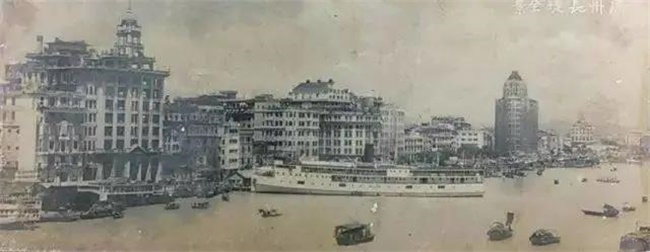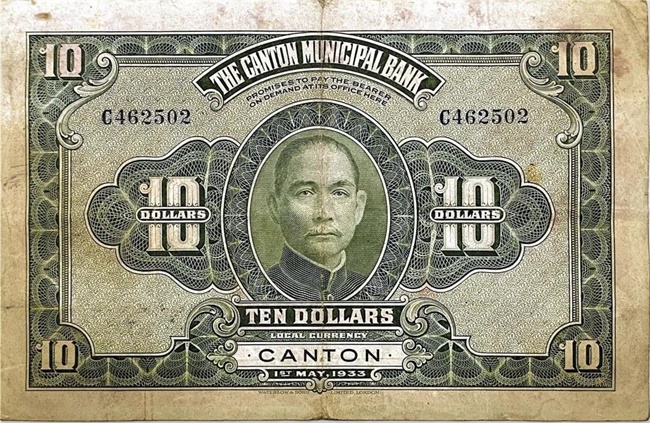
In Steel Structure Museum, there is a ten-yuan note issued by the Guangzhou Municipal Bank in the 22nd year of the Republic of China (1933). It is mainly red in the front, with a pattern frame around the four sides and the Chinese character meaning "ten" on the four corners. The Chinese characters of "Guangzhou Municipal Bank" were printed in an arc form from right to left on the top, with the symbol of the bank under them. In the rectangular box in the middle were printed a pattern of the famous steel structure in Guangzhou, Sun Yatsen Memorial Hall, and the characters of "Guangzhou Sun Yatsen Memorial Hall". On the right side of the pattern was written "General note payable to bearer" in two vertical lines, and on the left side was also written "Note payable to bearer interest-free, no replacement if lost, no addition or modification to the original writing" in two vertical lines. In the lower part of the note face was written "Ten Yuan Only", also with black signatures of "President Chen Zhongbi" and "Vice President Huang Hu" as well as characters of "Printed in the 22nd year of the Republic of China". In the lower part outside the box, "Printed by London Waterlow&Sons Company" was printed. The back of the notes was horizontal and mainly in gray and black, with the printed name of the bank in English and the number, C462502. A head portrait of Mr. Sun Yat-sen was printed in the middle. The number "10" was printed on the left and right sides and four corners. The lower part was a horizontal line that read "1st MAY, 1933".

Ten-Yuan Note Issued by the Guangzhou Municipal Bank Collected in Steel Structure Museum (front)
Guangzhou Municipal Bank was established by the Guangzhou Municipal Government during the period of the Republic of China in August 1927. It was the earliest, longest operating, and largest one of several city banks(such as Chongqing, Nanjing, Beiping, and Qingdao) founded during the period of the Republic of China period. Its purpose was recorded in the banking archives of the Guangzhou City, namely "to seek to assist the finance of Guangzhou City, the adjustment of finance, the development of industry and the convenience of tax payment". At the beginning, the bank had a registered capital of 1.00 million yuan in silver. At the same time, it enjoyed the following privileges granted by the Guangzhou Municipal Government: (1) Raising different bonds on behalf of the Municipal Government; (2) Acting as a cashier and collecting various public funds on behalf of the city's treasury; (3) Issuing exchange certificates of fractional money to circulate finance. To this end, the Guangzhou Municipal Bank began to issue vouchers (banknotes) from 1928 for 8 years until the government of the Republic of China promulgated the legal currency policy in 1935.

Guangzhou Municipal Bank was opened in Xihaokou, where regional banks stood in great numbers during the period of the Republic of China
According to the History of Local Banks in China published by Hunan Publishing House in 1991, Guangzhou Municipal Bank placed an order of printing 50,000 yuan to Waterlow&Sons,a London-based company, in September 1933. The notes were issued from 1934, while some of them were issued in the first half of 1935. Soon, the notes were no longer issued and used and were recovered and replaced with legal currency notes due to the enforcement of the legal currency policy. These notes issued by Guangzhou Municipal Bank were not circulated for a long time and were mainly confined to Guangzhou. So far, few of them have survived in the world, and they have high collection value.

Back side of the note
There were 4 main currencies of this note issued by Guangzhou Municipal Bank, designed with the patterns of "Guangzhou Sun Yatsen Memorial Tower" on the one-yuan note, "Guangzhou Sun Yatsen Memorial Hall" on the ten-yuan note, and "Guangzhou Municipal Government" on the 50-yuan note. The back was always a head portrait of Mr. Sun Yat-sen. These banknotes were very distinctive as the Chinese version was vertical on the front, like the note of customs gold unit issued by Shanghai, while the English version was horizontal on the back. This format was unique among the banknotes that appeared during the period of the Republic of China. In addition, a seven-character (Guangzhou Municipal Bank) note was issued in 1935, indicated with the year and month when this note was issued. It was similar to the bank notes issued by the official mint bureau, a feature that was not seen in other banknotes.